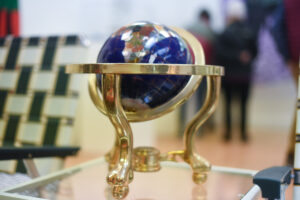If you visit our art gallery, you won’t find any real or crafted plants, any carved or photographed trees, any mapped or painted landscapes. Instead, in Makeba Rainey’s show LESS IS MORE: The Nature of Letting Go, you’ll see large fabric portraits overlaid with patterns of African wax cloth, a Kwanzaa altar, a wall of church fans, and a cozy corner stocked with books. And you may wonder: how is this environmental art?
The answer is both clear and complex—namely, we humans are also part of nature. We are not separate from our “environment” and the climate crisis is as much a social crisis as it is a material one, so its solutions must take both into account.
Tina continues, “I invited Makeba Rainey to the Schuylkill Center because I was fascinated by the care and respect her works embody for community, particularly the Black community in the region”—because Rainey’s LESS IS MORE is created specifically by and for Black people, a group (in Philadelphia and around the country) that has historically been subject to high levels of environmental racism, from unchecked air pollution and contaminated water to redlining in districts with comparatively little tree cover. The sacred and memorial space Rainey has created in the gallery offers a much-needed counter: an invitation for healing, rest, and rejuvenation. All are vital for building and sustaining Black community.
The show also pushes back against a dominant capitalist ideology of never-ending growth and linear progression, instead insisting that we are part of a cycle of life and death—and that cyclicality, with its inherent sustainability, is worth celebrating. Throughout the gallery, birth, life, and death coexist and move in a circle rather than a line: starting in one corner with midwifery artifacts from Rainey’s great aunt, tools for bringing new life into the world; moving on to a reading corner full of resources for life and accounts of lives lived; around to a memorial wall with church fans featuring photos of the recently deceased; and finally to a liminal space of an altar surrounded by two portraits, one of a late midwife, the other of a new mother and her child. Look closely and you’ll also find globes and spheres scattered through the space, underscoring this cyclicality.

Globes and circles can be found throughout the gallery, emphasizing the cyclical nature of life and death.
Moreover, the exhibition not only features Rainey’s work as a visual artist (the two portraits), but also other aspects of her practice: curation and community organizing. Indeed, Rainey directly created only a few items in the gallery and curated the rest from collaborators and community. A bouquet made by Meagan Cook of The Botanic Village and a t-shirt by Sudan Green both stand in memory of a friend killed by gun violence. A haunting and evocative soundscape by Julien Terrell plays from a corner. The church fans feature photos submitted by Philadelphians, while the book collection reflects lists curated by a host of Black librarians, booksellers, activists, and educators. Again and again, Rainey reminds us: care for each other and care for the planet will be found in community.
Similarly, the exhibition does not end where the gallery walls do. Rather, intrinsic to the show are the events programmed alongside it, opportunities to put the show’s themes into embodied practice: cultivating protected space Black community, honoring connection, and finding peace in letting go. These events, a birding outing on March 19 and an art and yoga workshop on March 26, are offered in partnership with In Color Birding Club and Spirits Up!, relationships Rainey brings with her as an artist. While it is easy to consider birding a scientific exercise and yoga a physical practice, in this context they’re imagined more holistically. Birding becomes a way to celebrate companionship, human and non-human alike, and yoga a way to nourish creativity and calm through the power of movement and breath.
Whether you identify as Black or not, we hope this show inspires you to think about the role our human relationships play in our relationships to other living beings, plants and animals. What does it mean to see environmental and social justice as one in the same, and how can we create systems that allow both to flourish? We invite you to cultivate the regenerative energy of community while exploring what sustainability looks like as a circle, not a line.
LESS IS MORE: The Nature of Letting Go is on view through March 26. To learn more about the Center’s art exhibitions, go to www.schuylkillcenter.org/art.
By Emily Sorensen, Exhibitions Coordinator

